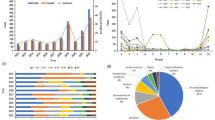Abstract
The Global Influenza Surveillance Network is crucial for monitoring epidemic risk in participating countries. However, at present, the network has notable gaps in the developing world, principally in Africa and Asia where laboratory capabilities are limited. Moreover, for the last few years, various influenza viruses have been continuously emerging in the resource-limited countries, making these surveillance gaps a more imminent challenge. We present a spatial-transmission model to estimate epidemic risks in the countries where only partial or even no surveillance data are available. Motivated by the observation that countries in the same influenza transmission zone divided by the World Health Organization had similar transmission patterns, we propose to estimate the influenza epidemic risk of an unmonitored country by incorporating the surveillance data reported by countries of the same transmission zone. Experiments show that the risk estimates are highly correlated with the actual influenza morbidity trends for African and Asian countries. The proposed method may provide the much-needed capability to detect, assess, and notify potential influenza epidemics to the developing world.
Article PDF
Similar content being viewed by others
Avoid common mistakes on your manuscript.
References
Best, N., Richardson, S., Thomson, A., 2005. A comparison of Bayesian spatial models for disease mapping. Stat. Methods Med. Res., 14(1):35–59. http://dx.doi.org/10.1191/0962280205sm388oa
Briand, S., Mounts, A., Chamberland, M., 2014. Challenges of Global Surveillance during an Influenza Pandemic. World Health Organization, Geneva. Available from http://www.who.int/influenza/surveillance_monitoring/Challenges_global_surveillance.pdf [Accessed on June 10, 2014].
Cooper, B.S., Pitman, R.J., Edmunds, W.J., et al., 2006. Delaying the international spread of pandemic influenza. PLoS Med., 3(6):e212. http://dx.doi.org/10.1371/journal.pmed.0030212
ECDC, 2009. Pandemic (H1N1) 2009. European Centers for Disease Control, Stockholm. Available from http://ec.europa.eu/health/communicable_diseases/diseases/influenza/h1n1/index_en.htm [Accessed on June 10, 2014].
Eubank, S., Guclu, H., Kumar, V., et al., 2004. Modelling disease outbreaks in realistic urban social networks. Nature, 429:180–184. http://dx.doi.org/10.1038/nature02541
Ferguson, N., Donnelly, C., Anderson, R., 2001. The footand- mouth epidemic in Great Britain: pattern of spread and impact of interventions. Science, 292(5519):1155–1160. http://dx.doi.org/10.1126/science.1061020
Ferguson, N., Cummings, D., Cauchemez, S., et al., 2005. Strategies for containing an emerging influenza pandemic in Southeast Asia. Nature, 437:209–214. http://dx.doi.org/10.1038/nature04017
Hay, S.I., Battle, K.E., Pigott, D.M., et al., 2013. Global mapping of infectious disease. Phil. Trans. R. Soc. B, 368(1614):20120250. http://dx.doi.org/10.1098/rstb.2012.0250
He, D., Dushoff, J., Eftimie, R., et al., 2013. Patterns of spread of influenza A in Canada. Proc. R. Soc. B, 280(1770):20131174. http://dx.doi.org/10.1098/rspb.2013.1174
He, D., Chiu, A., Lin, Q., et al., 2015a. Differences in the seasonality of Middle East respiratory syndrome coronavirus and influenza in the Middle East. Int. J. Infect. Dis., 40:15–16. http://dx.doi.org/10.1016/j.ijid.2015.09.012
He, D., Lui, R., Wang, L., et al., 2015b. Global spatiotemporal patterns of influenza in the post-pandemic era. Sci. Reports, 5:11013. http://dx.doi.org/10.1038/srep11013
Hollingsworth, T., Ferguson, N., Anderson, R., 2007. Frequent travelers and rate of spread of epidemics. Emerg. Infect. Dis., 13(9):1288–1294.
Keeling, M., Woolhouse, M., Shaw, D., et al., 2001. Dynamics of the 2001 UK foot and mouth epidemic: stochastic dispersal in a heterogeneous landscape. Science, 294(5543):813–817. http://dx.doi.org/10.1126/science.1065973
Kenah, E., Chao, D., Matrajt, L., et al., 2011. The global transmission and control of influenza. PLoS ONE, 6(5):e19515. http://dx.doi.org/10.1371/journal.pone.0019515
Lavanchy, D., 1999. The importance of global surveillance of influenza. Vaccine, 17:S24–S25.
Longini, I., Nizam, A., Xu, S., et al., 2005. Containing pandemic influenza at the source. Science, 309(5737):1083–1087. http://dx.doi.org/10.1126/science.1115717
Nelson, M.I., Viboud, C., Vincent, A.L., et al., 2015. Global migration of influenza A viruses in swine. Nat. Commun., 6:6696. http://dx.doi.org/10.1038/ncomms7696
Oshitani, H., Kamigaki, T., Suzuki, A., 2008. Major issues and challenges of influenza pandemic preparedness in developing countries. Emerg. Infect. Dis., 14(6):875- 880. http://dx.doi.org/10.3201/eid1406.070839
Riley, S., 2007. Large-scale spatial-transmission models of infectious disease. Science, 316(5829):1298–1301. http://dx.doi.org/10.1126/science.1134695
Tamerius, J., Shaman, J., Alonso, W.J., et al., 2013. Environmental predictors of seasonal influenza epidemics across temperate and tropical climates. PLoS Path., 9(3):e1003194. http://dx.doi.org/10.1371/journal.ppat.1003194
Wang, L., Li, X., 2014. Spatial epidemiology of networked metapopulation: an overview. Chin. Sci. Bull., 59(28): 3511–3522. http://dx.doi.org/10.1007/s11434-014-0499-8
WHO, 2014. Introduction of the Influenza Transmission Zones. World Health Organization, Geneva. Available from http://www.who.int/csr/disease/swineflu/transmission_zones/en/ [Accessed on June 10, 2014].
WHO Regional Office for Africa, 2009. Pandemic (H1N1) 2009 in the African Region: Update 63. World Health Organization, Brazzaville. Available from http://www.afro.who.int/index.php?option=com_docman&task=doc_download&gid=3954 [Accessed on June 10, 2014].
Williams, C., 2002. On a connection between kernel PCA and metric multidimensional scaling. Mach. Learn., 46(1): 11–19. http://dx.doi.org/10.1023/A:1012485807823
Zhou, X., Shen, H., 2010. Notifiable infectious disease surveillance with data collected by search engine. J. Zhejiang Univ.-Sci. C (Comput. & Electron.), 11(4):241–248. http://dx.doi.org/10.1631/jzus.C0910371
Zhou, X., Ye, J., Feng, Y., 2011. Tuberculosis surveillance by analyzing Google trends. IEEE Trans. Biomed. Eng., 58(8):2247–2254. http://dx.doi.org/10.1109/TBME.2011.2132132
Zhou, X., Li, Q., Zhu, Z., et al., 2013. Monitoring epidemic alert levels by analyzing Internet search volume. IEEE Trans. Biomed. Eng., 60(2):446–452. http://dx.doi.org/10.1109/TBME.2012.2228264
Author information
Authors and Affiliations
Corresponding author
Additional information
Project supported by the National Natural Science Foundation of China (Nos. 61103212 and 61471073) and the Chinese Post-Doctoral Science Foundation (Nos. 2012M521678 and 2013T60836)
ORCID: Xi-chuan ZHOU, http://orcid.org/0000-0002-3304-3045
Rights and permissions
About this article
Cite this article
Zhou, Xc., Tang, F., Li, Q. et al. Global influenza surveillance with Laplacian multidimensional scaling. Frontiers Inf Technol Electronic Eng 17, 413–421 (2016). https://doi.org/10.1631/FITEE.1500356
Received:
Accepted:
Published:
Issue Date:
DOI: https://doi.org/10.1631/FITEE.1500356




